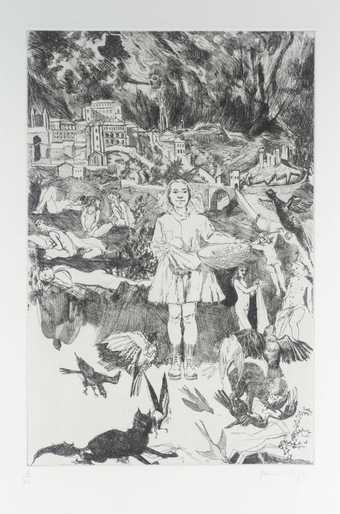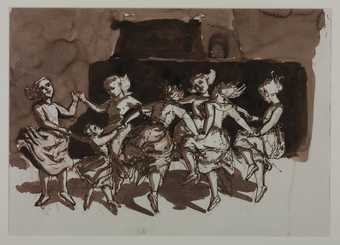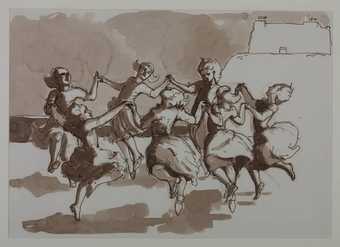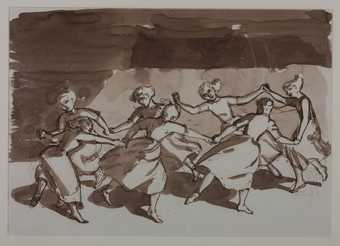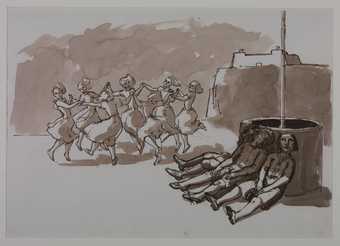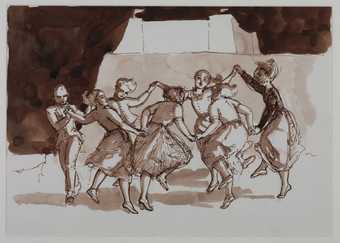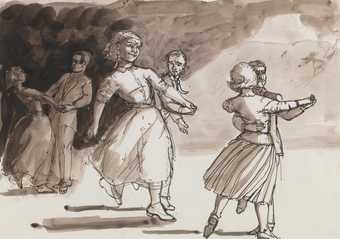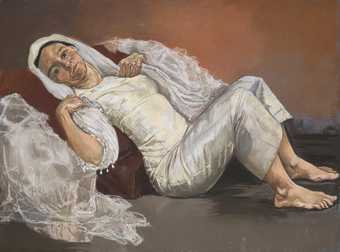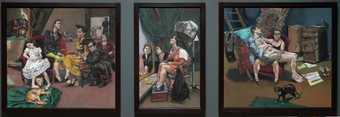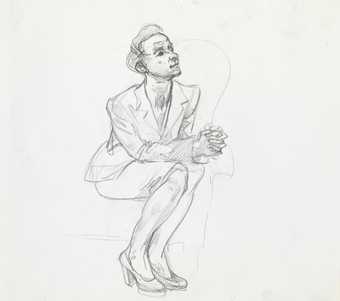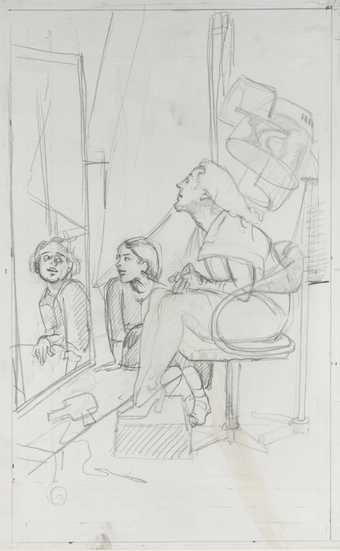
In Tate Modern
Exhibition
- Artist
- Paula Rego 1935 – 2022
- Medium
- Pastel on paper on aluminium
- Dimensions
- Frame: 1743 × 1343 × 60 mm
- Collection
- Tate
- Acquisition
- Presented by the artist (Building the Tate Collection) 2005
- Reference
- T12024
Summary
War 2003 is a large pastel work on paper, mounted on aluminium, by the Portuguese-born British artist Paula Rego. The image is dominated by two rabbit-headed figures in the centre, the larger one of which wears a blue dress and carries the smaller, who wears a frilly pink dress, has bloody marks around its eyes and mouth, and whose legs and arms resemble those of a soft toy. Behind these two figures on the left-hand side of the composition is an ant-like figure grappling with a brown hound, and a pelican embracing a woman. In the foreground stands a row of four figures: a stork with outstretched wings who has a talon inside the pink dress of another rabbit-headed figure, and a creature in a red dress with ribbons tied to its head glaring at a diminutive woman in soldier’s dress. A lifeless child or toy lying on the ground by the central pair, and a sitting cat in the top right-hand corner, add to the ominous ambiguity of the scene. The background of the work is divided into three blocks of colour – yellow at the bottom, muddy terracotta in the middle and a foreboding dark blue at the top containing a plume of black. These bands of colour retain traces of Rego’s sketchy mark making, in contrast to the figures, which are more heavily worked and consequently more opaque.
War was completed in London, where Rego moved permanently in 1976. The artist has claimed that the work was a response to a photograph published in the Guardian newspaper in the early stages of the Iraq War, which began in March 2003. The photograph featured a screaming girl in a white dress running from an explosion, while a woman and a baby remain stationary behind her. Rego explained, ‘I thought I would do a picture about these children getting hurt, but I turned them into rabbits’ heads, like masks. It’s very difficult to do it with humans, it doesn’t get the same kind of feel at all. It seemed more real to transform them into creatures’ (quoted in Museo Nacional Centro de Arte Reina Sofía 2007, p.268).
In addition to the newspaper image, Rego worked from a sculptural tableau constructed in her studio (models for the two central figures in War can be seen in a photograph reproduced in Fondation Calouste Gulbenkian – Délégation en France 2012, p.51). The artist has suggested other sources for the figures in the work. According to Rego, the small woman in the bottom-right corner of War is based on a childhood teacher of hers named Miss Cook, who played piano in a casino bar in Estoril (situated just to the west of Lisbon, where Rego was born) frequented by refugees escaping the Second World War. In War this figure, in Rego’s words, ‘saves a whole group of people’ (quoted in Museo Nacional Centro de Arte Reina Sofía 2007, p.268).
Rego’s use of pastels in War reflects a shift she made in 1994 from oil and acrylic paints. The artist has connected the experience of working with pastels with the more tactile processes she employed earlier in her career when she would sketch or compose collaged elements on the ground (Bradley 2002, p.68). She has also suggested that a desire for layering and flux while working on an image led to her switching materials: ‘Process is part of it, I don’t want to get exactly what I want the first time, because, you see, the changing it, the pushing it around, shoving it, makes it come alive. Rather than just doing it the first time.’ (Quoted in Museo Nacional Centro de Arte Reina Sofía 2007, p.192.)
Compositions combining animals, young girls and children’s toys, all of which appear in War, recur throughout Rego’s work, which often invokes the imagery of fairy tales with sinister or gothic overtones. Art historian Philippe Dagen has suggested that War be considered as ‘the nightmare which a child might have when the vision of death intrudes into its visual world’, a vision which may be generated by books or films and which ‘instantly perverts its previously happy and warm world’ (Philippe Dagen, ‘What War is Happening Here?’, in Fondation Calouste Gulbenkian – Délégation en France 2012, p.5).
War was first shown as part of an exhibition titled Jane Eyre and Other Stories held at the Marlborough Gallery, London, in October 2003, alongside a triptych and a suite of lithographs based on Charlotte Brontë’s novel. This combination demonstrates the pattern of Rego’s work in recent years: large thematic multi-part series and graphic works punctuated by individual images like War.
Further reading
Fiona Bradley, Paula Rego, London 2002.
Paula Rego, exhibition catalogue, Museo Nacional Centro de Arte Reina Sofía, Madrid 2007, p.268, reproduced p.227.
Paula Rego, Fondation Calouste Gulbenkian – Délégation en France, Paris 2012, pp.52–7, 124–5, reproduced p.125.
Amy Tobin
February 2014
Supported by Christie’s.
Does this text contain inaccurate information or language that you feel we should improve or change? We would like to hear from you.
Display caption
War was inspired by a news photograph taken during the recent Iraq war. A close-up of a young girl’s face dominated almost half of the photograph, while a woman in the background held her child stoically. Rego transformed the original image, using a cast of rabbits and other hybrid creatures. As in Rego’s earlier pastels, such figures hark back to a subversive and psychologically troubling tradition of folk tales and fairy tales that explore themes of violence and sexuality..
Gallery label, November 2006
Does this text contain inaccurate information or language that you feel we should improve or change? We would like to hear from you.
Film and audio
Explore
- objects(23,571)
-
- clothing and personal items(5,879)
-
- mask(172)
- toys and models(384)
-
- doll(46)
- actions: expressive(2,622)
-
- weeping(68)
- carrying / holding(866)
- woman(9,110)
- girl(1,079)
- wounded(135)
- dress: fantasy/fancy(506)
- war(358)
You might like
-
Paula Rego A Concise Definition of Answers
1996 -
Paula Rego Drawing for ‘The Dance’
1988 -
Paula Rego Drawing for ‘The Dance’
1988 -
Paula Rego Drawing for ‘The Dance’
1988 -
Paula Rego Drawing for ‘The Dance’
1988 -
Paula Rego Drawing for ‘The Dance’
1988 -
Paula Rego Drawing for ‘The Dance’
1988 -
Paula Rego Drawing for ‘The Dance’
1988 -
Paula Rego Drawing for ‘The Dance’
1988 -
Paula Rego Drawing for ‘The Dance’
1988 -
Paula Rego Bride
1994 -
Paula Rego Study for the Girl’s Mother in ‘Betrothal’ I
1999 -
Paula Rego Study for the Girl’s Mother in ‘Betrothal’ II
1999 -
Paula Rego Study for ‘Lessons’ II
1999

